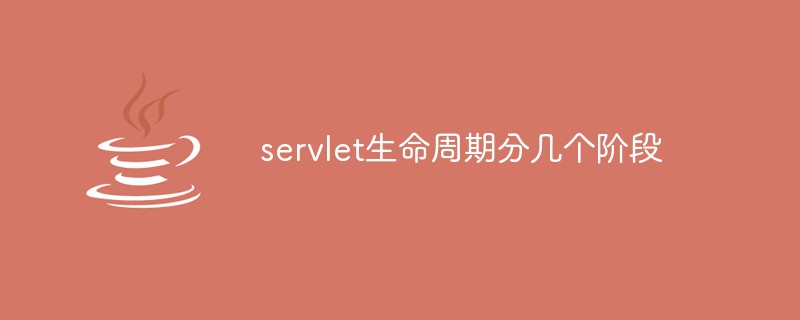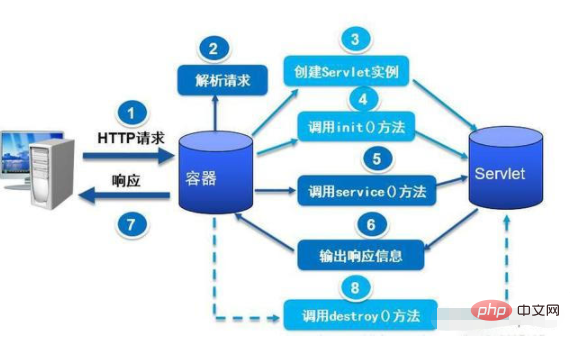Home >Java >Javagetting Started >The servlet life cycle is divided into several stages
The servlet life cycle is divided into several stages
- 青灯夜游Original
- 2023-02-23 13:46:2631600browse
Servlet life cycle refers to the entire process of servlet from creation to destruction, which can be divided into 3 stages: 1. Initialization stage, calling the init() method to implement the initialization work of Servlet; 2. Running stage (processing requests ), the container will create a ServletRequest object representing the HTTP request and a ServletResponse object representing the HTTP response for the specified request, and then pass them as parameters to the service() method of the Servlet; 3. Destruction phase.

The operating environment of this tutorial: windows7 system, java8 version, DELL G3 computer.
1. What is Servlet and its function?
Servlet (Server Applet) is the abbreviation of Java Servlet, is called a small service program or service connector, a server-side program written in Java, which has independent Platform and protocol characteristics, is a program running on a Web server or application server.
It is used as a server from a web browser or other HTTP client The middle layer between the request and the database or application on the HTTP server. The main function is to collect user input from web forms, interactively browse and generate data, and also generate dynamic web content.
2. Servlet life cycle
The Servlet life cycle can be defined as the entire process from creation to destruction .
The three steps are: initialization------> processing request------> destruction
After creating the Servlet object ---------->Initialization (call init () method)--------->Process/respond to customers End request (call service() method) --------->Destroy (call destroy() method, finally Garbage collection is performed by the JVM's garbage collector)
1) Initialization phase
When the client sends an HTTP request to the Servlet container to access the Servlet, the Servlet container first Parse the request and check whether the Servlet object already exists in the memory. If so, use the Servlet object directly. If not, create a Servlet instance object and then initialize the Servlet by calling the init() method. It should be noted that during the entire life cycle of a Servlet, its init() method can only be called once.2) Running phase (processing request)
This is the most important stage in the Servlet life cycle. In this stage, the Servlet container will create a representative for this request The ServletRequest object of the HTTP request and the ServletResponse object representing the HTTP response, and then pass them as parameters to the Servlet's service() method. The service() method obtains customer request information from the ServletRequest object and processes the request, and generates a response result through the ServletResponse object. During the entire life cycle of the Servlet, for each access request of the Servlet, the Servlet container will call the Servlet's service() method and create new ServletRequest and ServletResponse objects, that is, service() Methods will be called multiple times throughout the Servlet's life cycle.3) Destruction phase
When the server is shut down or the Web application is removed from the container, the Servlet is destroyed as the Web application is closed. Before destroying the Servlet, the Servlet container will call the Servlet's destroy() method to allow the Servlet object to release the resources it occupies. The destroy() method can only be called once during the entire life cycle of the Servlet. It should be noted that once the Servlet object is created, it will reside in the memory and wait for client access. The Servlet object will not be destroyed until the server is shut down or the web application is removed from the container.3. Detailed explanation of life cycle methods
Create a Servlet object and create a Servlet object through the server reflection mechanism. First It will be created upon request. (Default)
Call Servlet The object's init() method initializes Servlet information. The init() method will only be called once after creation (initialization phase) (1)
The init method is designed to be called only once. It is called when the Servlet is first created and will no longer be called on each subsequent user request. Therefore, It is used for one-time initialization, Created when the user calls the URL of the Servlet for the first time, or you can specify that the Servlet is loaded when the server starts for the first time.
(2)When the user calls a Servlet, a Servlet instance will be created, and each user request will generate a new thread, handed over to the doGet or doPost method when appropriate.
(3) The init() method simply creates or loads some data, These data will be used throughout the entire life cycle of the Servlet.
The init method is defined as follows:
public void init() throws ServletException {
// 初始化代码...
}
In response to the request, call service() or doGet(), doPost() method to process the request. These methods run in a multi-threaded state. (Response to client request phase)
(1) The service() method is the main method to perform actual tasks. It handles requests from the client (browser) and formats them. The response is written back to the client.
(2) Each time the server receives a Servlet request, the server will generate a new thread and call the service.
(3) The process of Servlet receiving and responding to customer requests. First, the customer sends a request. The Servlet calls the service() method to respond to the request. It can be seen from the source code that in the service() method Match the request method, choose to call doGet, doPost and other methods, and then enter the corresponding method to call the logic layer method to implement the response to the customer. Since there are no doGet, doPost, etc. methods in the Servlet interface and GenericServlet, these methods are defined in HttpServlet. Therefore, Every time we define a Servlet, we must implement doGet or doPost and other methods.
(4) service() method Check the HTTP request type (GET, POST, PUT, DELETE, etc.), and call doGet, doPost, doPut, doDelete when appropriate and other methods to process.
The service method is defined as follows:
public void service(ServletRequest request,ServletResponse response)
throws ServletException, IOException{
}Since the service() method is called by the container, the service method will call doGet, doPost, doPut, doDelete, etc. when appropriate. method. Therefore, We don’t need to do anything with the service() method. We only need to rewrite doGet() or doPost() according to the client’s request type.
is used to process requests, The method is run in multi-threaded state. (Response to customer request phase)
doGet() is the most commonly used method in service requests. It is used to process requests. When the request type of the URL is a GET request, Or if it is an unspecified request typeHTML form, then the request will be processed by the doGet() method.
The doGet method is defined as follows:
public void doGet(HttpServletRequest request,HttpServletResponse response)
throws ServletException, IOException {
// Servlet 代码
}
is used to process requests, and the method is run in a multi-threaded state. (Response to customer request phase)
doPost() is the most commonly used method in service requests. It is used to process requests when the request comes from a specially designatedrequest type as POST HTML form, then the request will be processed by the doPost() method.
The doPost method is defined as follows:
public void doPost(HttpServletRequest request, HttpServletResponse response)
throws ServletException, IOException {
// Servlet 代码
}
The destroy() method will be called to destroy the Servlet object when it has not been called for a long time or the server is shut down. (Termination phase) (1) The
destroy() method will only be called once, at the end of the Servlet life cycle.(2) The destroy() method allows the
Servlet to close the database connection, stop the background thread, write the cookie list or click counter to disk, and perform other similar cleanup activities.(3) After calling the destroy() method, the
servlet object is marked for garbage collection.The destroy method is defined as follows:
public void destroy() {
// 终止化代码...
}
4. Life cycle diagram It will be much easier to look at the period chart after understanding the above content.
 For more programming-related knowledge, please visit:
For more programming-related knowledge, please visit:
The above is the detailed content of The servlet life cycle is divided into several stages. For more information, please follow other related articles on the PHP Chinese website!

